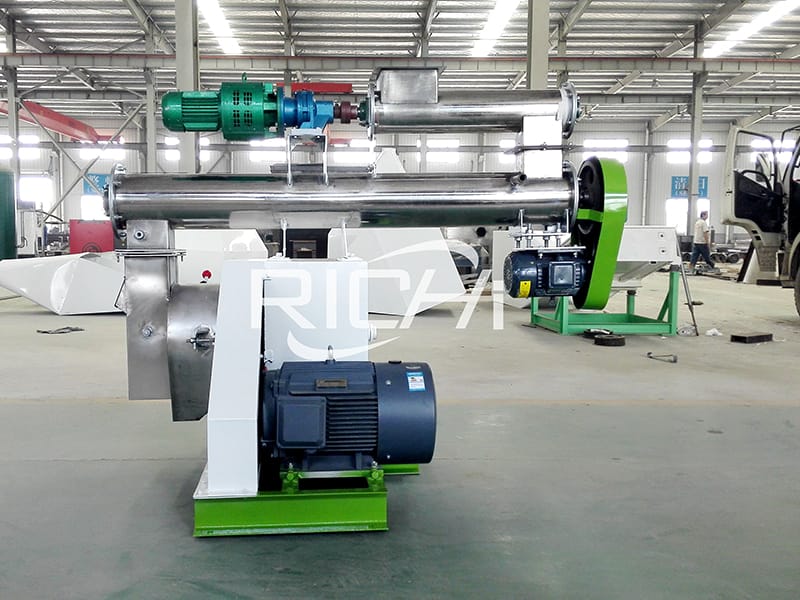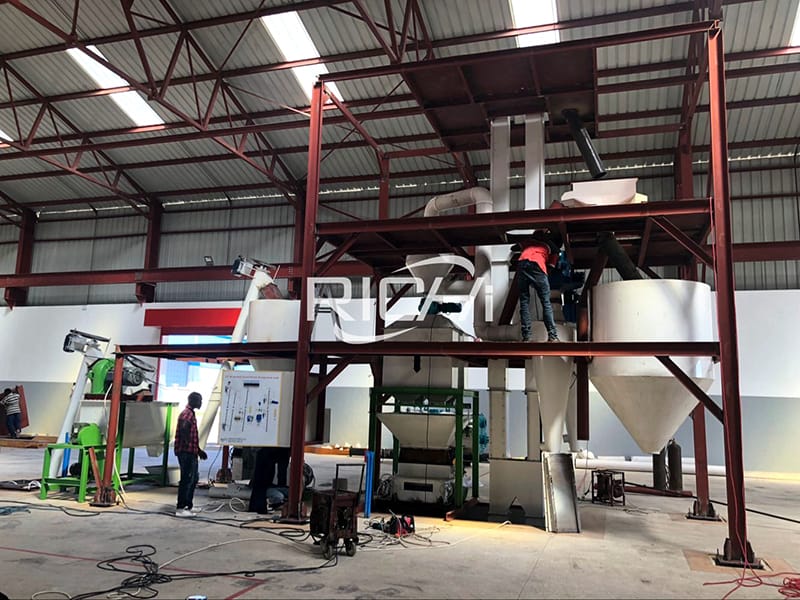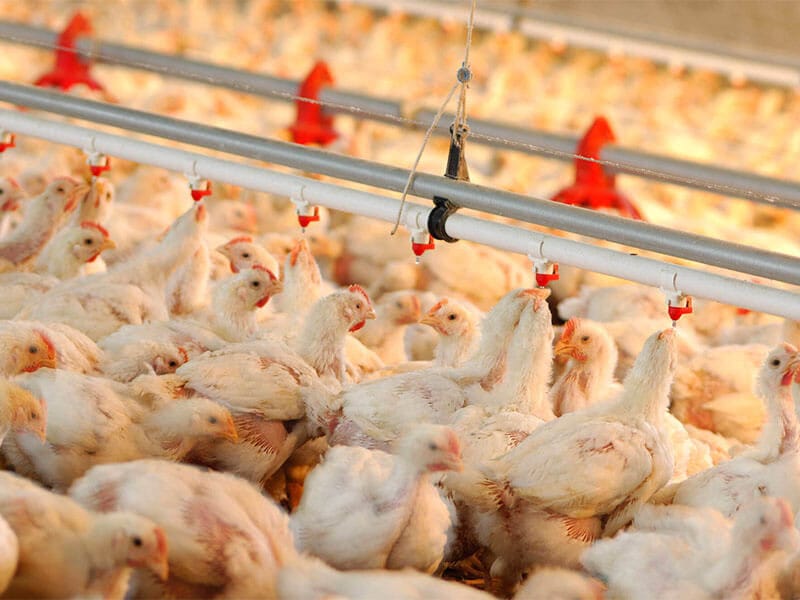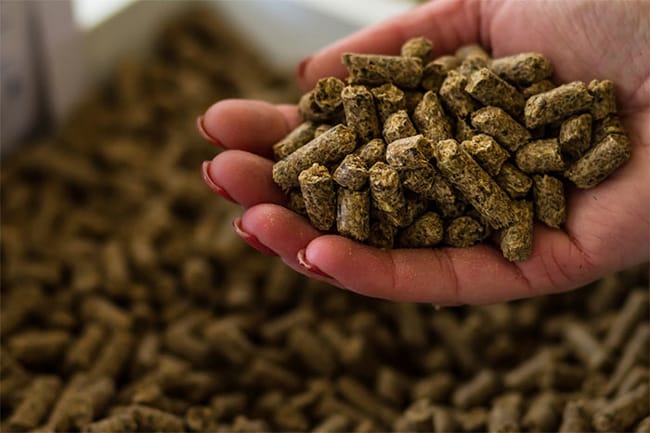RICHI SZLH 250 — 1-2 TPH Broiler Chicken Feed Pellet Making Machine (Bangladsesh Price & Specs)
1.RICHI SZLH 250 hot selling 1-2 ton per hour small capacity broiler chicken feed pellet making machine for sale Bangladsesh
RICHI 1-2 ton per hour broiler chicken feed pellet making equipment is mainly used to produce broiler animal feed pellets for chicken feed industry, there are several reasons why the chicken feed industry choose pellets,one reason 1-2 ton small capacity broiler chicken feed mill plant that with a 1-2 ton per hour broiler chicken feed pellet mill it is possible to create specific feed blends for specific animals. This way the broilers intake can also be precisely controlled. The other reason why they choose 1-2tph ring die chicken feed broiler pellet making machine is that much more pellets produced by chicken feed proessing plant can be stored in one location and in a good condition.
(1)SZLH25 broiler chicken feed making machine for pellet is key equipment for pellet feed and adapts to small broiler chicken feed mill factory with capacity under 1500TPY, farmers;
(2)It absorbed advantages of poultry broiler feed pellet mill from both domestic and abroad, combined with our experience;
(3)The feeder is controlled by infinite variable speed motor, which is easy for adjustment. The main driving system is gear motor;
(4)SZLH25 chicken feed pellet mill machine 6mm electric feed device for high producer broiler feed is with advantages for high output, low noise, low power consumption, long working life, easy maintenance. And it is with magnet and over load protection system, so it is safe and reliable.

2.Bangladsesh 1-2 ton per hour small broiler chicken feed machine prices
Capacity: 1-2Ton/Hour
With on-site electric control cabinet
Siemens motor, SKF bearing
Feature: Feeder, conditioner, ring die, door are made by stainless steel
Size of Conditioner: Length 1800mm* Diameter 220mm
Rang of Final pellet: 2-8mm
Ring die inter diameter: 250mm
1-2TPH China supplier low cost broiler chicken feed pelletizer equipment price for sale Bangladsesh: 7000USD-10000USD

3. Analysis of influencing factors of broiler feed and meat ratio
With the development of large-scale and industrialization of broiler farming, farms have gradually applied refined breeding to production practices during the breeding process. When it comes to refined broiler farming, we have to talk about the ratio of feed to meat. The feed-to-meat ratio occupies a pivotal role in breeding, because it is related to the level of production efficiency of the breeding farm and the size of the profit margin of breeding.
The feed-to-meat ratio of broilers refers to the amount of feed consumed by broilers per 0.5 kg of meat products. When calculating the feed-to-meat ratio of broilers, farmers need to comprehensively analyze many factors. Because there are many factors that affect the feed-to-meat ratio of chickens, they should always pay attention to these aspects in the process of feeding and management. The biggest profit margin. The author analyzes the common factors that affect feed meat as follows.
(1) Environmental factors
①Temperature influence
White feather broiler farming has a very strong dependence on temperature. During the brooding period, the chick needs a temperature of 33°C to 35°C. Later, as the age increases, the temperature should be gradually reduced until 25°C is stable. During this feeding process, if it is summer, in addition to providing temperature in the early period, the heating facilities can be removed later. However, it is raised in the winter in the north, and it must be kept warm during the whole process.
In order to reduce the cost of breeding, some farms have tried their best to control the cost of coal fires, thinking that this way the chickens can increase the feed intake and increase the growth rate. As everyone knows, the temperature in the chicken house does not reach the growth requirements of the chickens, which will indeed increase the feed intake, but after the feed enters the body, a large part of it will be converted into heat to keep out the cold, and part of it will provide energy for daily activities , The remaining part will be used for growth and weight gain. Over the long term, more feed is consumed, but the body weight of the chickens does not increase proportionally, resulting in a higher feed-to-meat ratio.
②Light influence
Under normal circumstances, the white feather broilers are given full light in the early stage of brooding, and then the light is reduced. The purpose of this is to give the chickens sufficient rest time, and then allow the feed to enter the body and fully absorb it to achieve the effect of growth and weight gain. If the chicken coop insists on full light for 24 hours, the chickens will not be able to rest. Although the feed consumption is increased, the feed can not be fully absorbed in the body because the chicken’s intestines are relatively short and the chickens have proper activity. Excreted from the body. The result of this is an increase in feed consumption without being converted into nutrients to be absorbed in the chicken body. The consequence is that the feed-to-meat ratio is relatively higher at the time of slaughter.

(2) Feeding management factors
In any breeding, breeding management plays a pivotal role. The purpose of broiler breeding is to grow and fatten quickly. In a breeding cycle, there are often sick and disabled chickens. Farmers must promptly pick out these chickens, because these chickens are weak and easily infected with diseases and infect healthy chickens. In addition, Because these chickens cannot be slaughtered normally, it will also increase the consumption of feed and affect the feed-to-meat ratio of the chickens.
In addition, in addition to three-dimensional cages, especially the chicken flocks raised on the ground and on the Internet, it is necessary to divide the flocks and increase partitions in a timely manner to provide the flocks with room for activities, but also to prevent excessive activity space, which affects growth and growth. weight.
(3) Disease factors
The high feed-to-meat ratio formed by the waste of feed caused by diseases occupies a large proportion in the breeding. Common gastrointestinal diseases such as enteritis, glandular gastritis, coccidia, nematodes, etc. If the chickens suffer from intestinal diseases, because the intestinal mucosa is inflamed, the feed will not be absorbed fully and effectively in the small intestine and will be excreted; if it is adenomyosis, the feed will not be effective in the stomach Softening and grinding, after entering the intestine, will seriously reduce the nutrient absorption rate due to the excessive size of the particles, and the unabsorbed feed will be excreted from the body. In this way, when healthy chickens and diseased chickens consume the same amount of feed, the healthy chickens will make full use of the feed, and the diseased chickens will absorb nutrients far less than the body needs. Increase feed intake, resulting in loss of feed.
Similarly, when chickens suffer from parasitic diseases, most of the nutrients will be absorbed by the parasites in the intestine after the feed enters the body, and only a small part of the nutrients will be used for the needs of the chickens. It is the increase in feed consumption, but the decrease in the proportion used for weight gain, resulting in an increase in the final feed to meat ratio.
In addition, when other diseases occur in the flock, although the feed intake of the flock does not decrease significantly from a visual point of view, the careful farmer will find that the weight does not increase during the period of the flock and the quality of the coat is also not good. In fact, the body redistributes the nutrients absorbed into the body. We know that the body’s nutrition is divided into only two parts, one part is for maintenance needs, the other part is for production needs. For white feather broilers, its production needs is gaining weight. When the body encounters cold, disease, and stress When other factors invade, in order to ensure that the body suffers the least loss, it will increase maintenance needs, and this increased nutrition comes from production needs. Then, when chickens are sick, in order to fight the pathogen, the body will continuously supply nutrients to the immune cells to improve the body's resistance. The reduction of nutrients needed for production will affect the body's weight gain.

(4) Nutritional factors
Nutrition factors are mainly manifested in the feed during the breeding process, and high-quality feed is the decisive factor in reducing the feed-to-meat ratio. The feed quality mainly includes the quality of raw materials, the degree of nutritional balance and processing technology.
①Raw material quality
Corn and soybean meal are the main sources of energy and protein in feed. The quality of corn and soybean meal in different production areas is different, and the energy and protein provided are also different. There are also differences when manufacturers purchase raw materials. Relatively speaking, large-scale enterprises have high requirements for the quality of feed because of their complete testing equipment. The product quality of some small feed mills is relatively unstable. This will result in different growth rates of chickens and different feed-to-meat ratios.
②The degree of nutritional balance
High-quality feed not only has high quality raw materials, but also has different nutritional standards for different stages of nutritional balance. As long as the farmers in the breeding process completely follow the divided stages to raise, the chickens can have a good growth rate and weight gain. However, if the nutrition of the feed is not balanced, it will affect the growth of the flock and increase the feed-to-meat ratio.
③Processing technology
If the same feed formula adopts different production processes, the feed remuneration is also different, such as the size of pellets, the degree of expansion, etc., which will eventually lead to different feed-to-meat ratios. (Related content: how to make chicken feed pellets for broilers )
(5) Chicks factor
In actual production, the quality and health of chicks also have a great impact on the feed-to-meat ratio in the future. The quality of chicks is good, the flocks are healthy, they can be fully absorbed after feeding, the growth rate is fast, and the weight gain effect is good. On the contrary, if the quality of chicks is poor, there are many weak chicks, and the gastrointestinal function is not fully developed, the growth rate will be slow, the weight gain will not be obvious, and even some weak chicks will die due to some unfavorable factors, which will seriously affect the flock's performance. Overall feed to meat ratio.
4. Case of 1-2 TPH broiler chicken feed manufacturing machine by Richi Machinery
- 1-2 ton per hour broiler chicken pellet milling machine in Tanzania chicken feed making plant
- broiler chicken pellet press machine for 1-2 ton per hour chicken poultry feed mill in Gambia
- ISO approved broiler chicken pellet production machine in Iraq small chicken feed processing plant
- 1-2 ton per hour machine for broiler chicken feed in Cape Verde full automatic chicken feed pellet production line with CE
- 1-2t/h broiler chicken poultry feed pelleting machine in Malawi complete set poultry animal feed pellet production line
- 1-2 ton per hour broiler chicken feed pellet making machine for widely used ring die pellet production line in sudan
- 1-2t/h broiler chicken pellet feed processing machine in Uzbekistan small scale chicken feed pellet making line
- 1-2t/h broiler chicken pellet feed equipment in Botswana small chicken pellet production making line


